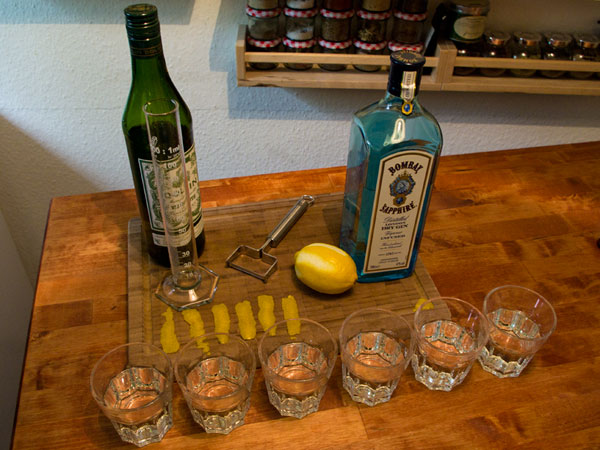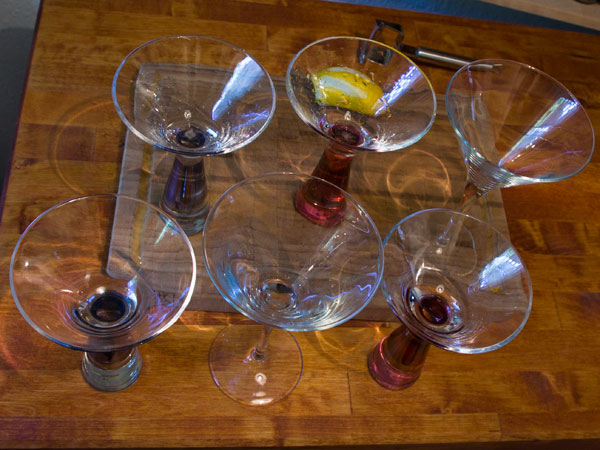When people think cocktail, most of them picture a drink in the iconic Martini glass. Mention a cocktail party and the first thought that comes to mind is elegantly dressed people standing around and drinking Martinis. The Martini is probably the most famous cocktail and it's time I took a closer look at this classic drink.
But with fame sometimes comes infamy and what some people call a Martini these days is often quite horrid. So it should be obvious that I give the Martini the same treatment I gave the Old Fashioned, right? Kind of.
Instead of writing over 3,000 words and drinking gin by the bottle, I want to focus on just one part that can make or break a Martini: The ratio of gin to vermouth. As a lucky coincidence this topic fits well within the 100th Mixology Monday motto Cocktail Chronicles. Hosted by cocktail virgin slut.
So for this theme, channel your inner Paul Clarke. Think about simplicity, elegance, and timelessness to the point that this drink would not feel strange about drinking and writing about this at MxMo M. – Cocktail
VirginSlut

Thank you Frederic Yarm for choosing such a great topic and thank you Paul Clarke for starting all of this. As this is only my second contribution I have to say it is a lot of fun and I look forward to another hundred months.
It might seem clichéd to choose such a popular cocktail as I will not even offer a twist or anything new. But I am tired of twists on the Martini. It is such a great cocktail that deserves a break from being bastardized! The Martini embodies elegance, timelessness and simplicity and therefore we should all try to learn why it became the iconic cocktail it is today.
We are all apprentices in a craft where no one ever becomes a master. – Ernest Hemingway
How To Properly Make A Martini
When checking the Wikipedia entry for a Martini it becomes clear that there seem to be many different ways on how to make one. And as an interesting article on liquor.com points out, the origins of this cocktail are a mystery, which makes finding the original recipe not easy. Several sources however, tell me that the Martini, at the start of the last century, consisted of equal parts vermouth and gin, as well as some orange bitters. These days the proper ratio seems to be 2:1, which even Paul Clarke himself recommends. So let's agree on that.
Martini
- 60ml London Dry Gin
- 30ml Dry Vermouth
- 1 Dash Orange Bitters
Add ice cubes and cracked ice to a mixing glass, then add all the ingredients. Make sure there is no ice above the fluid as this will only add unnecessary dilution. Gently stir for 30 seconds and strain into a pre-chilled Martini glass. Garnish with a lemon zest.[1]
From Wet To Dry
As mentioned earlier I want to focus purely on the ratio of gin to vermouth. It seems simple enough, but first I have to find out how this ratio affects the balance of the cocktail. I'm sure I will dive deeper into different gin and vermouth combinations in a future article. For now I will use Bombay Sapphire Gin (47% ABV) [1:1], Dolin Dry Vermouth and The Bitter Truth Orange Bitter as my ingredients of choice. This combination should give me a light and floral Martini.
I want to try the following gin-to-vermouth-ratios:
- Ratio 1 : 2 – 30ml Gin, 60ml Vermouth
- Ratio 1 : 1 – 45ml Gin, 45ml Vermouth
- Ratio 2 : 1 – 60ml Gin, 30ml Vermouth
- Ratio 3 : 1 – 67.5ml Gin, 22.5ml Vermouth
- Ratio 4 : 1 – 72ml Gin, 18ml Vermouth
- Ratio 7 : 1 – 78.75ml Gin, 11.25ml Vermouth
To get precise measurements I will use my graduated cylinder, which fills me with joy as I can pretend to be do something scientific. The amount of bitters and lemon zest will stay the same.

I prepared the different mixtures beforehand, so I can easily pour them into my mixing glass and make them one after another. This way I don't risk drinking warm Martinis.
Results
Gin-Vermouth 1 : 2
A very light and fruity cocktail. Almost like a white wine, it tastes like vermouth with subtle notes of juniper. I could imagine drinking this like you drink vermouth: On the rocks; before dinner. Definitely a nice cocktail, but nothing I'd call a Martini.
Gin-Vermouth 1 : 1
Lots of citrus notes and the vermouth is still strong. After the initial fresh taste the juniper comes forward and combines well with the floral vermouth and botanicals. Not a very strong cocktail, but as far as aperitifs go a good balanced drink. I can imagine that a sweet vermouth could easily overpower a light gin in this combination.
Gin-Vermouth 2 : 1
The juniper plays a more dominant role than in the previous mixture. The Martini is less fruity, but there are still lots of citrus notes. The gin isn't too strong while still playing the main part. You can probably use a more powerful vermouth and the gin will still shine through. I can see why this is the classic recipe.
Gin-Vermouth 3 : 1
Lots of juniper and coriander on the palate. Only a slight bitter taste from the vermouth. The citrus notes are not as dominant as earlier. This combination probably works with a light gin. I imagine a strong and dominant gin will overpower the vermouth. Maybe a strong vermouth could stand up to a gin here, so I'd try this with sweet vermouth or Noilly Prat Original Dry which isn't as subtle as the Dolin.
Gin-Vermouth 4 : 1
The gin is even more dominant and the vermouth is hardly recognizable. The gin botanicals drown out the vermouth, which is great if you like your gin neat. Only subtle hints of bitterness let you guess there was vermouth involved.
Gin-Vermouth 7 : 1
Maybe my taste buds are not developed enough, but I could probably drink cold gin and it would taste like this. The gin overpowers everything and you are left with a strong cocktail that I would not drink again unless forced to.

Conclusion
My personal favorite is the mixture with equal parts gin and vermouth. It's a light aperitif just like it should be. Using a stronger gin will work equally good while delivering a stronger juniper taste. To get another perspective I asked my girlfriend about her favorite mixture and she selected the classic 2:1 recipe. She likes gin more than vermouth, so this isn't a shocking revelation. It just shows me that you have to adjust every cocktail individually to the person it is intended for.
I'm always surprised by how difficult it is to make a cocktail with just three ingredients. I can only imagine how complicated it is to create a good Martini for someone you don't know: You have to choose your ingredients, select the right recipe and then mix everything together perfectly.
To cut a long story short: Everybody likes their Martini a different way. So find out which recipe you and the people you make cocktails for prefer. And don't bother testing as much different recipes as I did. I'm sure you will be content with a ratio of either 1:1, 2:1 or 3:1. If not then I can offer the following advice to you:
Whatever; mix it the way you like. If you prefer your martini with only the merest whiff of vermouth, then go for it, or if you like it up to equal parts gin and vermouth, there's a firm historical foundation (not to mention a culinary one) for going that direction. – Paul Clarke
Title image via pixabay.
Wrap up post of MxMo C on Cocktail Virgin.